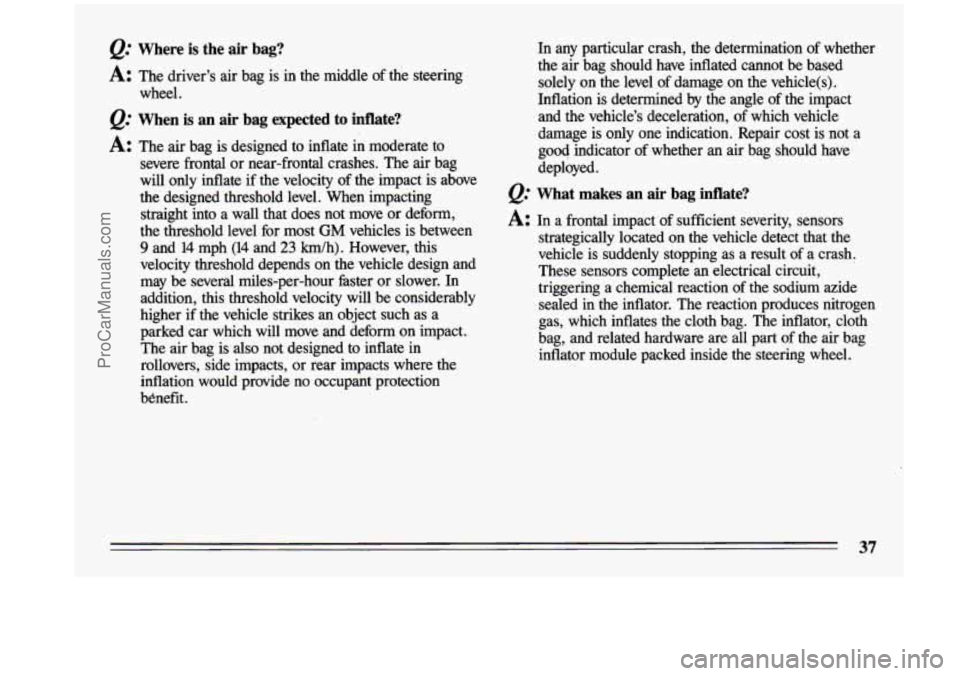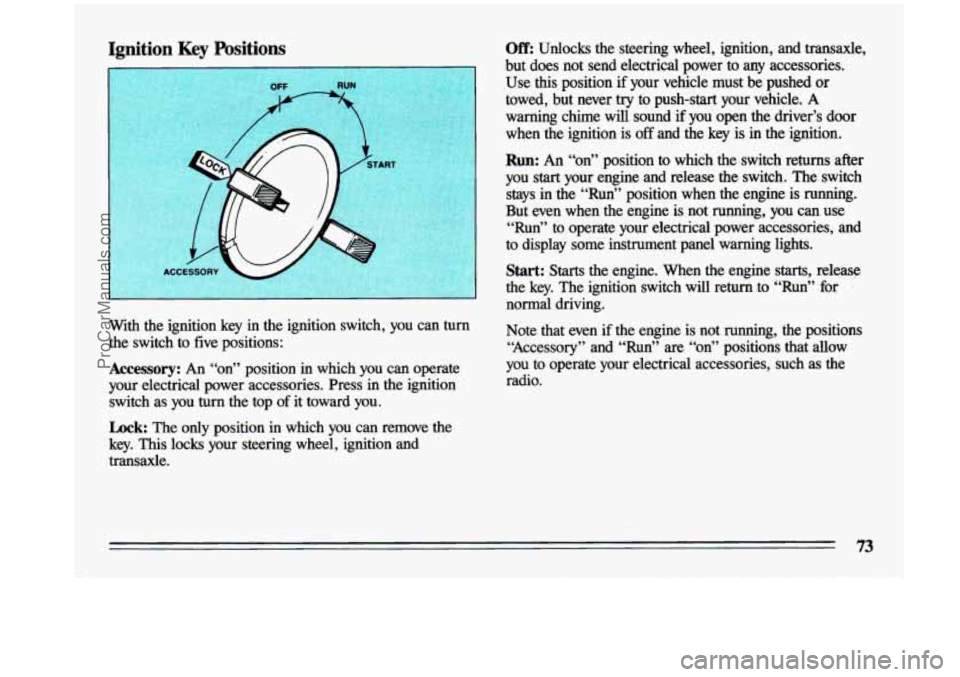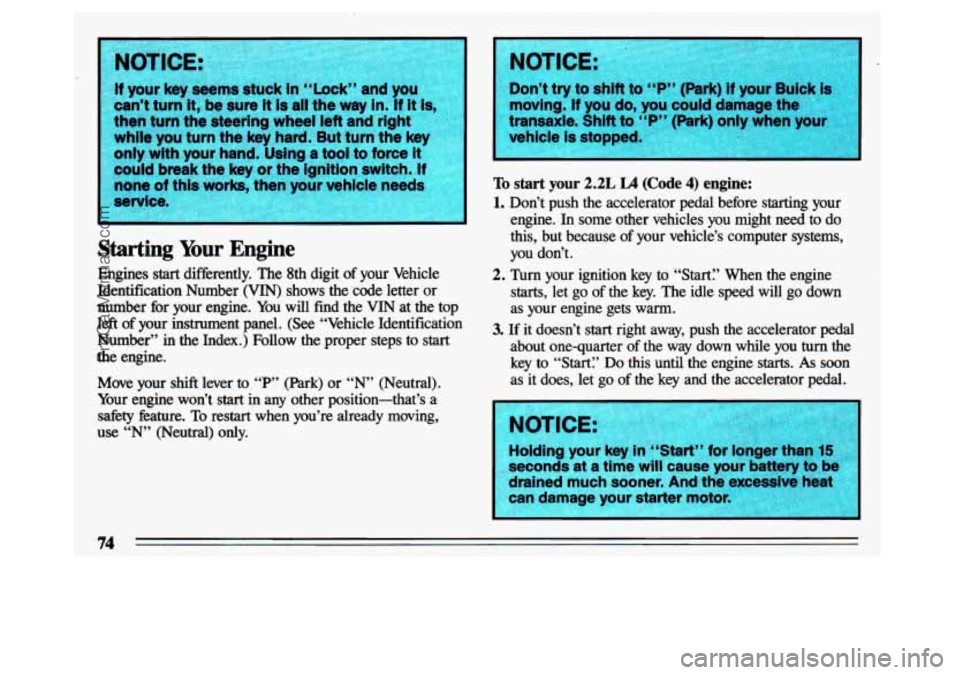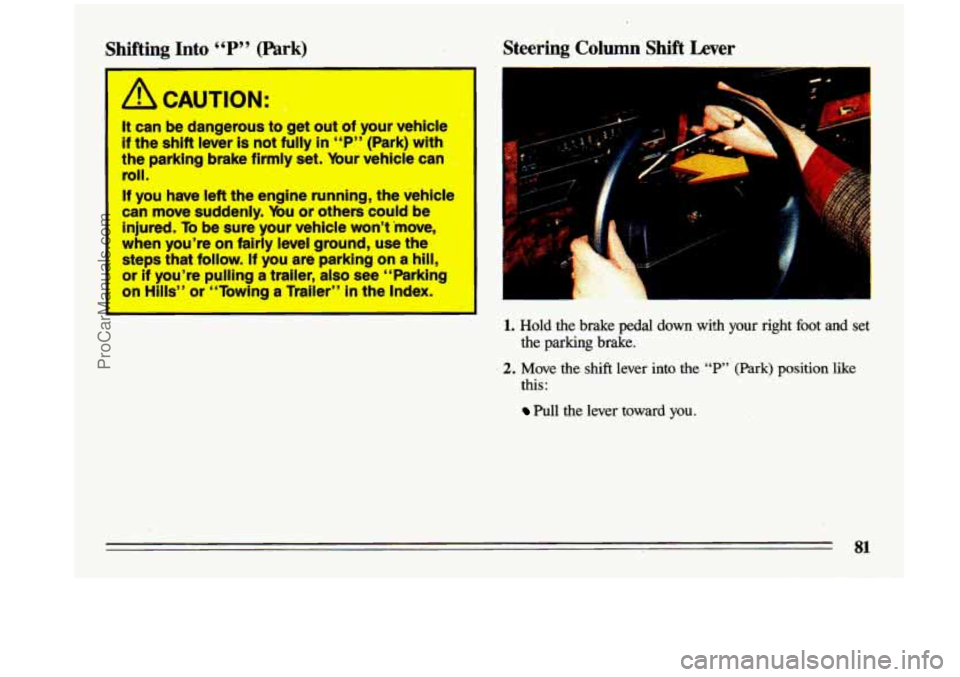1993 BUICK CENTURY steering
[x] Cancel search: steeringPage 39 of 324

Q: Where is the air bag?
A: The driver’s air bag is in the middle of the steering
wheel.
Q: When is an air bag expected to inflate?
A: The air bag is designed to inflate in moderate to
severe frontal or near-frontal crashes. The air bag
will only inflate if the velocity of the impact is above
the designed threshold level. When impacting straight into a wall that does not move or deform,
the threshold level for most
GM vehicles is between
9 and 14 mph (14 and 23 km/h). However, this
velocity threshold depends on the vehicle design and
may be several miles-per-hour faster or slower. In
addition, this threshold velocity will be considerably
higher if the vehicle strikes an object such as a
parked car which will move and deform on impact.
The air bag is
also not designed to inflate in
rollovers, side impacts, or rear impacts where the
inflation would provide
no occupant protection
benefit. In
any particular crash, the determination of whether
the air bag should have inflated cannot be based solely on the level of damage on the vehicle(s).
Inflation is determined by the angle
of the impact
and the vehicle’s deceleration, of which vehicle damage is only one indication. Repair cost is not a good indicator of whether
an air bag should have
deployed.
Q: What makes an air bag inflate?
A: In a frontal impact of sufficient severity, sensors
strategically located on the vehicle detect that the
vehicle is suddenly stopping as a result of a crash.
These sensors complete an electrical circuit, triggering a chemical reaction of the sodium azide
sealed in the inflator. The reaction produces nitrogen
gas, which inflates the cloth bag. The inflator, cloth
bag, and related hardware are
all part of the air bag
inflator module packed inside the steering wheel.
37
ProCarManuals.com
Page 40 of 324

How does an air bag restrain?
A: In moderate to severe frontal or near-frontal
collisions, even belted occupants
can contact the
steering wheel. The air bag supplements the
protection provided by safety belts. Air bags
distribute the force of the impact more evenly over
the occupant’s upper body, stopping
the occupant
more gradually. But air bags would not provide
protection in many types
of collisions, including
rollovers and rear and side impacts, primarily
because an occupant’s motion is not toward the air
bag. Air bags should never be regarded as anything more than a supplement to safety belt protection in
moderate to severe frontal and near-frontal
collisions.
Qt What will you see after an air bag inflation?
A: After the air bag has inflated, it will then quickly
deflate.
This occurs so quickly that some people
may not even realize that the air bag inflated. The
air bag will
not impede the driver’s vision or ability
to steer the vehicle, nor will it hinder the occupants from exiting the vehicle. There will be
small
amounts of smoke coming from vents in the deflated
air bag. Some components of the air bag module in
the steering wheel hub may be hot
for a short time,
but the portion
of the bag that comes into contact
with you
will not be hot to the touch. The nitrogen
gas used to inflate the
air bag will have vented into
the passenger compartment, and the bag will be
deflated within seconds after the collision. Nitrogen
makes up about
80% of the air we breathe and is not
hazardous.
As the nitrogen vents from the bag, small
particles are also vented into the passenger compartment.
ProCarManuals.com
Page 41 of 324

A CAUTION:
Don’t attach anything to the steering wheel
pad.
It might injure the driver if the air bag
inflates.
The air bag
is designed to inflate only once.
After
it inflates, you’ll need some new parts for
your air bag system. If you
don’t get them, the
air bag system won’t be there
to help protect
you
in another crash. A new system will
include the air bag module and possibly other
parts. The service manual has information
about the need
to replace other parts.
Let only qualified technicians work
on your air
bag system. Improper service can mean that
your air bag system won’t work properly. See
your dealer for service.
Servicing Your Buick with the Air Bag
System
Please tell or remind anyone who works on your Buick
that it has
the air bag system. There are parts of the air
bag system in several places around your vehicle.
You
don’t want the system to inflate while someone is
working on your vehicle. The air bag system does not need regular maintenance. Your Buick
dealer and the
1993 Century Service Manual have information about the
air bag system, including repair
or disposal.
A CAUTION:
For up to 2 minutes after the ignition key is
turned
off and the battery disconnected, an air
bag can still inflate during improper service.
Yonn
can be injured if you are close to an air bag whc..
it inflates. Be sure to follow the proper service
procedures.
I
When electrical work is done under the hood or inside
your vehicle, the ignition should be
in “Lock” if possible.
Avoid wires wrapped with yellow tape, or yellow
connectors. They are probably part of the air bag system.
But if the ignition has to be on for electrical work, or if
the steering column is
to be disassembled, the air bag
system must be disconnected.
To do this:
Turn off the ignition.
Remove the SIR (air bag) fuse (see “Fuses & Circuit
Disconnect the yellow connector at the base of the
Breakers” in the Index).
steering column.
3V
ProCarManuals.com
Page 65 of 324

n
part 2 Features and Controls
Here you can learn about the many standard and optional features on your Buick. and informat\
ion on starting.
shifting and braking . Also explained are the instrument panel and the warning systems that tell you if everything
is working properly-and what to do if you have a problem .
Part 2 includes:
Keys ........................................................................\
........
Locks ........................................................................\
...... 65
Remote Keyless Entry System ........................................................... 66
New Vehicle Break-In ................................................................. 72
Ignition ........................................................................\
..... 73
Starting Your Engine .................................................................. 74
Shifting the Transaxle ........................................... : ..................... 77
parking Brake ........................................................................\
80
ShiftingIntoPark ..................................................................... 81
Windows ........................................................................\
... 84
Horn ........................................................................\
....... 86
TiltSteeringWheel ................................................................... 86
Turn Signal/Headlight Beam Lever ....................................................... 86
Windshield Wipers, Washer ........................................................... 88
CruiseControl ..................................................................... 91
InteriorLights ....................................................................... \
95
Headlights ........................................................................\
.. 95
Mirrors ........................................................................\
..... 98
Instrument Panel ..................................................................... 105
Warning Lights, Gages and Indicators .................................................. 106
63
ProCarManuals.com
Page 73 of 324

/r CAUTION:
It can be dangerous to drive with the liftgate or
liftglass open. Carbon monoxide (CO) gas can
come
into your vehicle. You can’t see or smell
CO.
It can cause unconsciousness and even
death.
If you must drive with the liftgate or liftglass
open:
Make sure all other windows are shut.
Turn the fan on your heating or cooling
system
to its highest speed with the setting
on NORM
or VENT. That will force outside air
into your vehicle. See “Comfort Controls’’ in
.the Index.
instrument panel, ope1 hem all the way.
If you have air vents on or under the
Glove Box
Use the door key to lock
and unlock the glove box.
To open, pinch the latch
release.
Theft
Vehicle theft is big business, especially in some cities.
Although
your Buick has a number of theft deterrent
features, we know that nothing we put on it can make it
impossible to steal. However, there are ways you can
help.
Key in the ignition: If you walk away from your vehicle
with the keys inside, it’s an easy target for
joy riders or
professional thieves-so don’t do it. When you park your
Buick and open the driver’s door, you’ll hear
a chime
reminding
you to remove your key from the ignition and
take it with you. Always do this. Your steering wheel will
be locked, and
so will your ignition and transaxle. And
remember to lock the doors.
n
ProCarManuals.com
Page 75 of 324

Ignition Key Positions Off: Unlocks the steering wheel, ignition, and transaxle,
but does not send electrical power to any accessories.
.Use
this position if your vehicle must be pushed or
towed, but never try to push-start your vehicle.
A
warning chime will sound if you open the driver’s door
when the ignition
is off and the key is in the ignition.
I
Run: An “on” position to which the. switch returns after
you
start your engine and release the switch. The switch
stays in the “Run” position when the engine is running.
But even when the engine is not running, you can use
“Run” to operate your electrical power accessories, and
to display some instrument panel warning lights.
Start: Starts the engine. When the engine starts, release
the key. The ignition switch will return to “Run” for
normal driving.
with the ignition key
h the ignition switch, YOU can turn Note that even if the engine is not running, the positions
the switch to five positions: “Accessory” and “Run” \
are “on” positions that allow
.Accessory: An “on” position in which you can operate you to operate your electrical accessories, such as the
your electrical power accessories. Press
in the ignition ‘ radio.
switch as you
turn the top of it toward you.
Lock: The only position in which you can remove the
key. This locks your steering wheel, ignition
and
transaxle.
ProCarManuals.com
Page 76 of 324

I I.
If your key &ems suwn in ‘‘Lu~n IU Y~U
can’t turn it, be sure it is all the way in. If it is,
then turn the steering wheel left and right
while you turn the key hard. But turn the key
only with your hand. Using
a tool to force it
could break the key or the ignition switch. If
none
of this works, then your vehicle needs
service.
I
Starting Your Engine
Engines start differently. The 8th digit of your Vehicle
Identification Number (VIN) shows the code letter or
number for your engine. You will find the VIN at the top
left of your instrument panel. (See “Vehicle Identification
Number” in the Index.) Follow the proper steps to
start
the engine.
Move your shift lever to
“P” (Park) or “N” (Neutral).
Your engine won’t
start in any other position-that’s a
safety feature.
To restart when you’re already moving,
use “N” (Neutral) only.
To start your 2.2L L4 (Code 4) engine:
1. Don’t push the accelerator pedal before starting your
engine. In some other vehicles you might need to do
this, but because
of your vehicle’s computer systems,
you don’t.
starts, let go of the key. The idle speed will go down
as your engine gets warm.
3. If it doesn’t start right away, push the accelerator pedal
about one-quarter of the way down while you turn the
key
to “Start;’ Do this until the engine starts. As soon
as it does, let go of the key and the accelerator pedal.
2. Turn your ignition key to “Start:’ When the engine
74
ProCarManuals.com
Page 83 of 324

Shifting Into “P” (Park)
,3
/i CAUTION: ~
It can be dangerous to get out of your vehlcle
if the shift lever is not fully in “P” (Park) with ,
the parking brake firmly set. bur vehicle can -.
roll.
If you have left the engine runnin.g, the vehicle
can move suddenly. ybu
or others could be
injured. To be sure your vehicle won’t inwe,
when you’re on fairly level ground, Use the ‘
steps that follow. If you are parking on a hill,
or if you’m pulling a trailer, also see. “Parking
on Hills” or “Towing B Trailer” in the Index.
Steering Column Shift Lever
1. Hold the brake pedal down with your right foot and set
the parking brake.
2. Move the shift lever into the “P” (Park) position like
this:
Pull the lever toward you.
81
ProCarManuals.com